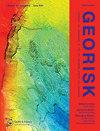地下地层学训练图像数据库的开发
IF 4.8
3区 工程技术
Q1 ENGINEERING, GEOLOGICAL
Georisk-Assessment and Management of Risk for Engineered Systems and Geohazards
Pub Date : 2023-01-02
DOI:10.1080/17499518.2023.2169942
引用次数: 2
摘要
摘要基于图像的随机模拟方法,如多点统计(MPS),可以被视为一种基于物理学的贝叶斯学习方法,它从单个训练图像中采样典型的地层模式,用于地下地层的进一步条件建模。训练图像本质上是先验地质模型,其包括感兴趣地点的代表性地层连通性。阻碍基于图像的地质建模方法广泛应用的一个关键困难是缺乏合格的训练图像。在本研究中,提出了一个系统框架来开发用于地下地层学条件模拟的训练图像数据库。收集的训练图像可以根据三个关键因素进行进一步分类,即地质来源、场地位置和应用场景。作为一项试点研究,我们收集了香港花岗岩和凝灰岩风化斜坡的54个地质剖面,主要由经验丰富的工程人员解释,并将其汇编为两个训练图像数据库。为了证明所建立的训练图像数据库的价值和应用,使用了真实风化花岗岩斜坡实例的地下地层学作为说明性实例,并对地层不确定性进行了量化。结果表明,训练图像数据库对地下地层学和不确定性量化具有重要意义,尤其是当只有有限的特定场地数据可用时。本文章由计算机程序翻译,如有差异,请以英文原文为准。
Development of training image database for subsurface stratigraphy
ABSTRACT Image-based stochastic simulation methods, such as multiple point statistics (MPS), can be viewed as a physics-informed Bayesian learning approach, which samples typical stratigraphic patterns from a single training image for onward conditional modelling of subsurface stratigraphy. A training image is essentially a prior geological model, which comprises representative stratigraphic connectivity at the site of interest. One key difficulty hindering wide application of image-based geological modelling methods is the lack of qualified training images. In this study, a systematic framework is proposed to develop training image databases for conditional simulations of subsurface stratigraphy. Collected training images can be further categorised based on three key factors, namely, geological origin, site location and application scenario. As a pilot study, a total of 54 geological cross-sections, mainly interpreted by experienced engineering practitioners, for weathered granite and tuff slopes in Hong Kong are collected and compiled as two training image databases. To demonstrate value and application of the established training image databases, subsurface stratigraphy for real weathered granite slope examples are used as illustrative examples, and stratigraphic uncertainty is also quantified. Results indicate that training image databases are of great significance for subsurface stratigraphy and uncertainty quantification, particularly when only limited site-specific data are available.
求助全文
通过发布文献求助,成功后即可免费获取论文全文。
去求助
来源期刊
CiteScore
8.70
自引率
10.40%
发文量
31
期刊介绍:
Georisk covers many diversified but interlinked areas of active research and practice, such as geohazards (earthquakes, landslides, avalanches, rockfalls, tsunamis, etc.), safety of engineered systems (dams, buildings, offshore structures, lifelines, etc.), environmental risk, seismic risk, reliability-based design and code calibration, geostatistics, decision analyses, structural reliability, maintenance and life cycle performance, risk and vulnerability, hazard mapping, loss assessment (economic, social, environmental, etc.), GIS databases, remote sensing, and many other related disciplines. The underlying theme is that uncertainties associated with geomaterials (soils, rocks), geologic processes, and possible subsequent treatments, are usually large and complex and these uncertainties play an indispensable role in the risk assessment and management of engineered and natural systems. Significant theoretical and practical challenges remain on quantifying these uncertainties and developing defensible risk management methodologies that are acceptable to decision makers and stakeholders. Many opportunities to leverage on the rapid advancement in Bayesian analysis, machine learning, artificial intelligence, and other data-driven methods also exist, which can greatly enhance our decision-making abilities. The basic goal of this international peer-reviewed journal is to provide a multi-disciplinary scientific forum for cross fertilization of ideas between interested parties working on various aspects of georisk to advance the state-of-the-art and the state-of-the-practice.

 求助内容:
求助内容: 应助结果提醒方式:
应助结果提醒方式:


